Download Altinex MULTI-TASKER MT110-101 User`s guide
Transcript
MULTI-TASKER MANUAL PART NUMBER: 400-0197-004 MT110-101/103 8 X 8 MONO AUDIO MATRIX SWITCHER TM CARD FOR MULTI-TASKER USER’S GUIDE MULTI-TASKER TABLE OF CONTENTS Page PRECAUTIONS / SAFETY WARNINGS ...............2 GENERAL ..........................................................2 INSTALLATION..................................................2 CLEANING.........................................................2 FCC / CE NOTICE..............................................2 ABOUT YOUR MT110-101/103.............................3 TECHNICAL SPECIFICATIONS............................3 DESCRIPTION OF MT110-101/103 ......................4 APPLICATION DIAGRAM .....................................4 APPLICATION 1.................................................4 APPLICATION 2.................................................5 INSTALLING YOUR MT110-101/103 ....................6 OPERATION .........................................................6 TROUBLESHOOTING GUIDE ............................11 ALTINEX POLICY ...............................................12 LIMITED WARRANTY......................................12 RETURN POLICY ............................................12 CONTACT INFORMATION ..............................12 1 1 MULTI-TASKER PRECAUTIONS / SAFETY WARNINGS 1 • Please read this manual carefully before using your MT110-101/103. Keep this manual handy for future reference. These safety instructions are to ensure the long life of your MT110-101/103 and to prevent fire and shock hazard. Please read them carefully and heed all warnings. 1.1 GENERAL • Qualified ALTINEX service personnel, or their authorized representatives must perform all service. 1.2 INSTALLATION • To prevent fire or shock, do not expose this unit to rain or moisture. Do not place the MT110-101/103 in direct sunlight, near heaters or heat radiating appliances, or near any liquid. Exposure to direct sunlight, smoke, or steam can harm internal components. • Handle the MT110-101/103 carefully. Dropping or jarring can damage the card. • Do not pull the cables that are attached to the MT110-101/103. • Insert the card carefully into the slots of the Multi-Tasker™ without bending any edges. • When removing a card, please make sure that the card to which it is attached is also pulled out simultaneously. • 1.3 CLEANING • Clean only the connector area with a dry cloth. Never use strong detergents or solvents, such as alcohol or thinner. Do not use a wet cloth or water to clean the card. Do not clean or touch any component or PCB. 1.4 FCC / CE NOTICE • This device complies with part 15 of the FCC Rules. Operation is subject to the following two conditions: (1) This device may not cause harmful interference, and (2) this device must accept any interference received, including 2 2 interference that may cause undesired operation. This equipment has been tested and found to comply with the limits for a Class A digital device, pursuant to Part 15 of the FCC Rules. These limits are designed to provide reasonable protection against harmful interference when the equipment is operated in a commercial environment. This equipment generates, uses, and can radiate radio frequency energy and, if not installed and used in accordance with the instruction manual, may cause harmful interference to radio communications. Operation of this equipment in a residential area is likely to cause harmful interference in which case the user will be required to correct the interference at his own expense. Any changes or modifications to the unit not expressly approved by ALTINEX, Inc. could void the user’s authority to operate the equipment. MULTI-TASKER ABOUT YOUR MT110-101/103 2 TECHNICAL SPECIFICATIONS MT110-101/103 8-in 8-out Mono Audio Matrix Switcher Card FEATURES/DESCRIPTION GENERAL Inputs Input Connectors The MT110-101/103 is a Balanced Audio Matrix Switching Card designed for use with the MultiTasker system. When installed in a MultiTasker, this card allows any input to be independently switched to any of the outputs. All inputs and outputs can be wired for unbalanced or balanced audio, allowing longer cable runs and superior noise resistance. 3 MT110-101/103 (4) 5-pin Terminal Blocks Outputs (4) 5-pin Terminal Blocks Stereo or Mono Audio Compatibility Table 1. MT110-101/103 General Output Connectors MECHANICAL MT110-101/103 Basic Enclosure Slots Two Required Weight 1.0 lb (0.45 kg) Connector Panel Black T° Operating 10°C-35°C T° Maximum 0 to 50°C Humidity 90% non-condensing MTBF (calc.) 40,000 hrs Table 2. MT110-101/103 Mechanical The MT110-101 is an 8x8 audio matrix with fixed gain of 0db. The MT110-103 is an 8x8 audio matrix with variable gain for each input. As “transparent” distribution amplifiers, these cards utilize AC coupling on their inputs for ideal signal transfer characteristics. Switching is controlled with easy-to-use ASCII commands from a control system or computer connected to the RS-232 port of a Multi-Tasker™ enclosure. Each card consumes two slots in a Multi-Tasker enclosure, and all input and output connections are accomplished via captive screw terminal blocks. ELECTRICAL Input Signals Max Level Impedance Audio Throughput Although designated as an 8x8 matrix switcher, the MT110-101/103 can be used in a variety of ways to provide different capabilities. For example, one 8x8 card can handle mono audio while two 8x8 cards handle stereo audio, or a single 8x8 card can be used to create an 4x4 stereo audio matrix. Gain Frequency Response MT110-101/103 0 dBu 10k Ohms 0 dB unbalanced, 6dB balanced 10 Hz to 20 kHz (+/- 0.05 dB) -100 dB @ 20 kHz >80 dB, 10 Hz to 20 kHz Noise Floor CMRR Output Signals Level 1V p-p Impedance Low – drives 600 Ohms Gain 0 dB Power Power from Power +6V -6V MT100-100 Consumption MT110-101/103 135mA 110mA 1.5 watts Table 3. MT110-101/103 Electrical 3 3 MULTI-TASKER DESCRIPTION OF MT110-101/103 4 APPLICATION DIAGRAM Application 1 4 4 5 MULTI-TASKER Application 2: Internal View of MT110-103 Application 2: Internal View of MT110-101 5 5 MULTI-TASKER INSTALLING YOUR MT110-101/103 6 OPERATION Step 1. Slide the MT110-101/103 into an available slot in the Multi-Tasker™ Basic Enclosure in order to connect to the bus. Make sure that the MT110-101/103 card fits into place. Secure the card to the MultiTasker™ by tightening the retainer screws located on the top and bottom of the MT110-101/103 card. 7 7.1 RS-232 CONTROL When used in the Multi-Tasker™ Enclosure, the MT110-101/103 has many advanced remote control capabilities, which are accessible through standard RS-232 communication. The actual controlling can be accomplished through a computer control system or any other device capable of sending RS-232 commands. Step 2. The LED on the card panel will turn red indicating that the card is in full operation. An LED that is blinking red indicates that the card is experiencing a problem. If the LED is blinking, see Troubleshooting Guide in section 8. 7.1.1 RS-232 INTERFACE The RS-232 commands for the MT110-101/103 are in a simple ASCII character format. 1. Square brackets “[ ]” are part of the command. 2. Use uppercase letters for all commands. After processing a command, an OK or ER will be returned as feedback if "F" is included at the end of a command string or if the unit ID is zero. Step 3. Connect audio cables from the audio source to the input connector of the MT110-101/103. Connect the output connectors of the MT110-101/103 to the audio equipment through an audio cable. 7.2 DESCRIPTION OF COMMANDS Step 4. Starting from the left, identify the slot number where the MT110-101/103 card is plugged into the Enclosure and note that it is for RS-232 control. Each command consists of three parts: function, card ID, and unit ID. [Function, Card ID, Unit ID] Example: [VERC3U2] VER = Function C3 = Card ID U2 = Unit ID For detailed information regarding function, see each command description. Card ID is an assigned value from 1 to 19, which represents the number of slots. Card ID 0 (C0) is used for the controller (see user’s guide for the MT100-100). Changing the position of a card will significantly affect the commands recorded on software definitions or a third party control system. Unit ID has a value from 0 to 9. Unit ID 0 should be used for single unit operation. If the Unit ID is set to 0, then each command can be used without Ui (use command [SETU0]; see user’s guide for the MT100-100). Example: [VERC3]: for unit ID zero [VERC3Ui]: for unit ID other than zero 6 6 MULTI-TASKER [VERC3]: equivalent to [VERC3U0] Input4 is connected to Output5 and Output5 is disabled Input5 is connected to Output6 and Output6 is disabled Input7 is connected to Output7 and Output7 is disabled Input8 is connected to Output8 and Output8 is disabled Note: If there is no card in slot #2 of unit 3, sending the [C2U3] command will not return any feedback. 1. [VER] This command receives the software version and card type for the MT110-101/103 card. Command Format: [VERCnUi] Cn = card ID number (n = # from 1 to 19) Ui = Unit ID (i = # from 0 to 9) (refer to the MT100100 user’s guide for explanation) Example: ERROR CODES If one MT110-101 card is in slot #2 of unit 3: ER01: CPU Error To send command [VERC2U3], the Multi-Tasker™ Enclosure will return: MT110-101 690-0152-004 This error indicates that the CPU is not working properly. 2. [C] ER02: I²C Communication Error This command receives the status of the card. Command Format: [CnUi] Cn = card id (n = 1 to 19) Ui = unit id (i = from 0 to 9) (refer to the MT100-100 user’s guide for explanation) This means that the communication between the MT110-101/103 card and its serial device has failed. ER03: RS485 Communication Error This type of error is a communication error between the MT110-101/103 card and the controller of the Multi-Tasker™ Enclosure. Example: If one MT110-101/103 card is in slot #2 of unit 3 with output 1, 2 & 3 ON: When sending command [C2U3], feedback will be returned as: Config. 8x8 offset: IN=0 OUT=0 In1 Out1 ON In3 Out2 ON In6 Out3 ON In2 Out4 OFF In4 Out5 OFF In5 Out6 OFF In7 Out7 OFF In8 Out8 OFF 3. [CiS] This command is to save card status such as ON/OFF, IN/OUT, and volume control. 4. [IO] This command will connect input x with output y, but the user needs to use the [ON] command to enable this output. Command Format: [IxOyCnUi] Ix: select input x, x is from 1 to 8 Oy: connect to output y, y is from 1 to 8 Cn: card ID number, n is from 1 to 19 Ui: unit ID, i is from 0 to 9. (Refer to MT100-100 user’s guide to set Unit ID). Description of Feedback: Input1 is enabled Input3 is enabled Input6 is enabled Input2 is disabled connected to Output1 and Output1 is Example: To connect input 4 to output 2 (card 2 of unit 3), use the [I4O2C2U3] command. [ImO*Ci] Connect Input m to all Outputs connected to Output2 and Output2 is connected to Output3 and Output3 is connected to Output4 and Output4 is 5. [OSImCi] This command is set Input offset 7 7 MULTI-TASKER m -from 0 to 128. executed ( [SW] ). Commands ending in "P" are not executed immediately. The path for outputs on multiple cards or the same card can be loaded. 6.[OSOnCi] This command is set Output offset n - from 0 to 128 7. [ON] This command enables one or more outputs of a single card or group of cards. • Command Format: [ONmCnUiP] m = output number (m =1 to 8) n = card ID No. (n = a slot # from 1 to 19) P = path [ONmCnUi]: for a single card Example: This command enables output “m” without affecting any other outputs. Default when plugged in = ALL OFF If 2 cards are at slot 6 and 7 of unit 3: To enable output 1 and 2 of card 6 and output 3 and 4 of card 7 simultaneously, use the following commands: m = Output number (m = 1 to 8) n = Card ID number (n = 1 to 19) i = Unit ID number (i = 0 to 9) [ON12C6U3P] [ON34C7U3P] [SW] If "F" is included use the [ONmCnUiPF] command or the [ONmCnUiFP] command. Example: 1) [ON12C5U3]: Turns ON only output 1 and 2 of the MT110-101/103 card located in slot #5 of the MT100-100 Enclosure with unit ID3. 2) [ON3C5U3]: Turns ON only output 3 of the MT110-101/103 card located in slot #5 of the MT100-100 Enclosure with unit ID3. After the [ON12C5U3] and [ON3C5U3] commands have been executed, output 1, 2 and 3 will be ON. 3) [ONC5U3]: Turns ON all outputs of the card. • • After processing a command, an OK or ER will be returned as feedback if "F" is included at the end of a command string or if the unit ID is zero. Example: [ON1C2U3F]: if path is not set [ON1C2U3PF]: if path is set [ONmGkUi]: for a group of cards 8. [OFF] This command enables output "m" for each card in group "k" of unit "i". This command disables one or more outputs of a single card or a group of cards. m = card output (m = # from 1-8) k = group number (k = # from 1-9) i = unit number (i = # from 0-9) • [OFFmCnUi]: for a single card This command disables output “m” without affecting any other outputs. Example: m = output number (m = 1 to 8) n = card ID No. (n = slot # from 1 to 19) i= Unit ID number (i = 0 to 9) 1. [ON1G5U1]: Turns ON output 1 for each card in group 5 of unit 1. 2. [ONG5U1]: Turns ON all outputs for each card in group 5 of unit 1. • [ON…..F]: feedback [OFFCnUi]: Turns OFF all outputs of the card Example: [ON….. P]: sets path 1) If card 5 of unit 3 has output 1, 2 and 3 ON: a) [OFF1C5U3]: Turns OFF output 1 while This command will set the path for the output, but it is not active until the switch command is 8 8 MULTI-TASKER output 2 and 3 remain ON. b) [OFF23C5]: Turns OFF output 2 and 3. 2) If card 5 of unit 3 has output 1, 2, 3, 4, 5, 6, 7 and 8 ON: After processing a command, an OK or ER will be returned as feedback if "F" is included at the end of a command string or if the unit ID is zero. a) [OFFC5U3]: Turns OFF all outputs, which is equivalent to [OFF12345678C5U3]. • Example: [OFF1C2U3F]: if path is not set [OFF1C2U3PF]: if path is set [OFFmGkUi]: for a group of cards 9. [SW] – Switch This command disables output "m" for each card in group "k" of unit "i". The switch command immediately connects inputs and outputs, which were previously set with the path command on this card or any other cards in the MT100-100. Command Format: [OFFmCnUiP] m = card output (m = # from 1-8) k = group number (k = # from 1-9) i = unit number (i = # from 0-9) Example: Example: [ON12C6U3P] [ON34C7U3P] [SW] 1. [OFF1G5U1]: Turns OFF output 1 for each card in group 5 of unit 1. 2. [OFFG5U1]: Turns OFF all outputs for each card in group 5 of unit 1. • The system will return feedback as OK if the unit ID is zero. [OFF…..P]: sets path 10. [SIGCi] This command will set the path for the output, but it is not active until the switch command is executed ( [SW] ). Commands ending in "P" are not executed immediately. The path for outputs on multiple cards or the same card can be loaded. This command checks if signal is present. Example: If signal on IN1 for the MT110-101/103in slot 4 after sending command string [SIGC4] received feedback will be 1. Command Format: [OFFmCnUiP] 11. [CLR] m = number (m =1 to 8) n = card ID No. (n = a slot # from 1 to 19) P = path This command clears the members for a single group or for all nine groups. Command Format: [CLRGkUi] Example: k = group number (k = # from 1-9) i = unit number (i = # from 0-9) If 2 cards are at slot 6 and 7 of unit 3: To enable output 1 and 2 of card 6 and output 3 and 4 of card 7 simultaneously, use the following commands: 12. [VOLnAkCi] This command sets volume for each input in the MT110-103 only. n = output number (n = # from 1-8) k = gain level (k=1 to 16) i = unit number (i = # from 0-9) [OFF12C6U3P] [OFF34C7U3P] [SW] If "F" is included use the [OFFmCnUiPF] command or the [OFFmCnUiFP] command. • 13. [SELmCn] [OFF…..F]: feedback 9 9 MULTI-TASKER This command sets path to adjust the individual volume level for single card. Command Format: [SELmCn] [–] [–] [–] [–] or [+] [+] [+] [+] m = Input number (m = 1 to 8) n = Card ID number (n = slot # from 1 to 19) + = increases volume.(maximum of 15 levels for audio). – = decreases volume.(maximum of 15 levels for audio). O1c O1d O2a O2b O2c O2d 15. [HELPCi] This command displays all available for user MultiTasker interface commands. 14. [MATmXnCi] This command allows changes in the configuration of the matrix. User can configure the MT110-101 and MT110-103 Audio Matrix Switcher as 8x8, 4x4, or 2x2. 7.3. SUMMARY OF COMMANDS 1) [VER]: Receives software version 2) [C]: Receives status of the card 3) [CiS]: Save card status 4) [IO]: Connects the input to the output 5) [OSI]: Set input offset 6) [OSO]: Set output offset 7) [ON]: Turns on one input for a single card or a group of cards 8) [OFF]: Turns off one or more inputs for a single card or a group of cards 9) [SW]: Switch (outputs the preloaded buffer) 10) [SIG]: Checks if signal present 11) [CLR]: Clears members of a single group or all groups 12) [VOL]: Sets volume 13) [SEL]: Select input to adjust volume 14) [MATmXnCi]: Change configation of matrix. 15) [HELPCi]: Display commands. 8x8 Input Output O1a O2a O3a O4a O5a O6a O7a O8a O1a O2b O3b O4b O5b O6b O7b O8b 4x4 Input Output O1a O1b O2a O2b O3a O3b O4a O4b O1a O1b O2a O2b O3a O3b O4a O4b TROUBLESHOOTING GUIDE 2x2 Input Output O1a O1b O1a O1b O1c O1d O2a O2b O2c O2d 8 We have carefully tested and have found no problems in the supplied MT110-101/103; however, we would like to offer suggestions for the following: • 10 10 8.1 LED IS NOT LIT MULTI-TASKER • • • • 8.2 LED IS BLINKING RED 8.3 NO SOUND 8.4 SOUND DISTORTION 8.5 SOUND LEVEL IS LOW working properly. - If the CPU is not working, you will receive an ER01 message. The system will return feedback as [On1 ER01 C05] when using card 5 of unit 1. 8.1 LED IS NOT LIT A) Cause 1: Card cage is not plugged in. Solution: Plug card cage in. If the LED lights, the problem is solved. If the LED is still not lit, see Cause 2. - ER01 Code: CPU error Solution 1: Look at the card and verify that there is no damage. If there is no damage, see Solution 2. B) Cause 2: Card is not plugged in all the way. Solution 2: Verify that all IC’s are seated in their sockets. If the LED is still blinking red, see Solution 3. Solution: Push the card in all the way. If the LED is still not lit, see Cause 3. C) Cause 3: Solution 3: Call ALTINEX at (714) 990-2300. B) Cause 2: Card cage slot has a problem. Solution 1: Test the card in other slots of the card cage. If the slot was damaged, the card may work in other slots. If other slots work and the LED lights, the problem is the card cage slot. The card cage may require service. Call ALTINEX at (714) 990-2300. If the other slots do not work and the LED is still not lit, see Solution 2. - If there is no communication between the MT110-101/103 card and its serial device, you will receive an ER02 message. The system will return feedback as [On1 ER02 C05] when using card 5 of unit 1. - ER02 Code: Communication error between the MT110-101/ 103 card and its serial device. Solution 2: Take any other known good card with an LED and verify that the slot used is good by seeing if the other card’s LED lights in that slot. If it lights, then the original card may be the source of the problem. Call ALTINEX at (714) 990-2300. Solution 1: Turn the system OFF and then ON again. If there is still an error message, see Solution 3. Solution 2: Call ALTINEX at (714) 990-2300. 8.3 NO SOUND A) Cause 1: The source has a problem. Solution: 8.2 LED IS BLINKING RED If the LED on the card is blinking red, find the error code. For example, if you are using card 5 of unit 1, send the [C5U1] command to see the status and error code. Note that card 5 refers to slot 5. A) Cause 1: The MT110-101/103 card and its serial device are not communicating. B) Cause 2: The CPU on the card is not 11 11 Check the source and make sure that it is working at an appropriate volume level and all source connections are correct. If the source is working and there is still no sound, see Cause 2. The proper card input may not be selected. MULTI-TASKER Solution: C) Cause 3: Solution: D) Cause 4: Select the card input that is used, by RS-232 accessible commands in section 7. If no sound is present, see Cause 3. sound level is still low, see Solution 2. Solution 2: Cable connections to the destination are incorrect. B) Cause 2: Poor signal transmission. Make sure that cables are connected properly. Also, make sure that the continuity and wiring are good. If there is still no sound present, see Cause 4. Solution: ALTINEX POLICY Solution 2: Set the volume of the destination amplifier to a reasonable level. If there is still no sound, call ALTINEX at (714) 990-2300. B) Cause 2: Please refer to Altinex web site for details on product warranty. 9.2 RETURN POLICY The source level is above 1V p-p. Please refer to Altinex web site for details on return policy. Make sure that the source level is below 1V p-p. If the sound is still distorted, see Cause 2. 9.3 CONTACT INFORMATION ALTINEX, INC. 592 Apollo Street Brea, CA 92821 USA The destination amplifier provides excessive amplification. Solution 1: Make sure that the source signal level is high enough so that the destination amplifier does not have to provide excessive amplification and thereby distort the signal. If there is still sound distortion, see Solution 2. Solution 2: Call ALTINEX at (714) 990-2300. TEL: 714-990-2300 TOLL FREE: 1-800-ALTINEX WEB: www.altinex.com E-MAIL: [email protected] FAX: 714-990-3303 8.5 SOUND LEVEL IS LOW A) Cause 1: The volume levels are inappropriate. Solution 1: 9 9.1 LIMITED WARRANTY 8.4 SOUND DISTORTION Solution: Check the cables for continuity and make sure that connections are wired properly to verify that there is good signal transmission. Note: Test the system by removing MT110-101 card from between the source and the destination amplifier. If problem persists, call ALTINEX at (714) 990-2300. The destination amplifier has a problem. Solution 1: Make sure that the destination amplifier is powered. If there is still no sound, see Solution 2 A) Cause 1: Turn up the destination amplifier volume. If the sound level is still low, see Cause 2. Turn up the source volume. If 12 12













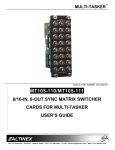
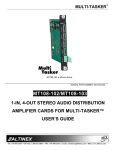
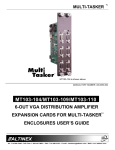

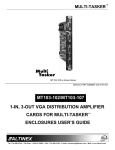
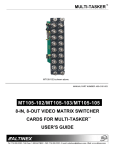
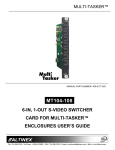

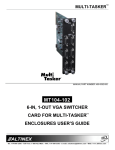
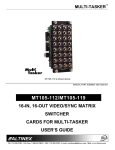

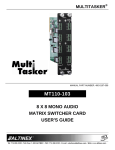
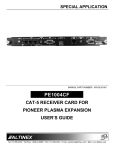




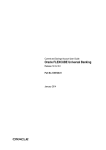
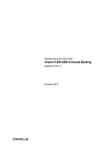
![[August] [2010] Oracle Part Number E51575-01](http://vs1.manualzilla.com/store/data/005654822_1-60fccbb787b73d73a8aa90efa0003782-150x150.png)

